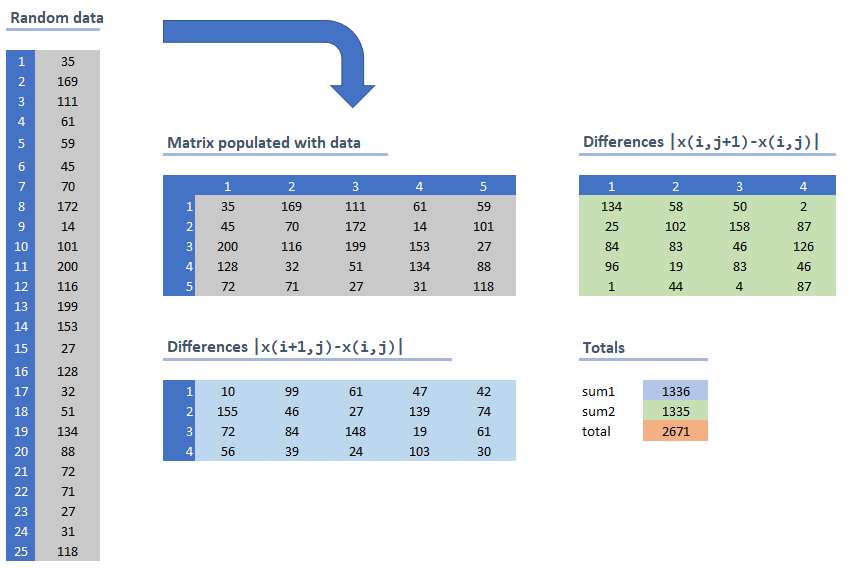- We have \(n\) groups of volunteers. Groups have different sizes (number of volunteers).
- There are \(m\) volunteer sites with a certain demand for volunteers.
- Try to assign volunteers to sites such that we don't split up groups if not needed.
We can recognize a transportation model in the description of the problem. We have \(n\) supply nodes (the volunteer groups) and \(m\) demand nodes (the volunteer sites).
| Transportation model |
|---|
| \[\begin{align} \min & \sum_{i,j} \color{DarkBlue} c_{i,j} \color{DarkRed} x_{i,j}\\ & \sum_j \color{DarkRed} x_{i,j} \le \color{DarkBlue}{\mathit{Supply}}_{i} &&\forall i \\ & \sum_i \color{DarkRed} x_{i,j} = \color{DarkBlue}{\mathit{Demand}}_{j} &&\forall j \\ & \color{DarkRed}x_{i,j} \ge 0 \end{align} \] |
Here we assume total supply is equal or exceeds total demand. If total demand ls larger than total supply, we can use as constraints \[\begin{align}& \sum_j \color{DarkRed} x_{i,j} = \color{DarkBlue}{\mathit{Supply}}_{i} &&\forall i \\ & \sum_i \color{DarkRed} x_{i,j} \le \color{DarkBlue}{\mathit{Demand}}_{j} &&\forall j \end{align}\] In the special case where total demand is equal to total supply, we can use either formulation, or alternatively \[\begin{align} & \sum_j \color{DarkRed} x_{i,j} = \color{DarkBlue}{\mathit{Supply}}_{i} &&\forall i \\ & \sum_i \color{DarkRed} x_{i,j} = \color{DarkBlue}{\mathit{Demand}}_{j} &&\forall j \end{align}\]
OK, we had to make one assumption. Besides that we have two more issues:
- The variables \(x_{i,j}\) should be integer value: we cannot divide up a volunteer.
- The objective is not correct. We need somehow to model "split up as few groups as possible". One interpretation could be: minimize the number of links \(i \rightarrow j\) that we use. Putting it differently: find the sparsest solution for \(x_{i,j}\).
 |
| Bipartite graph representation |
| Minimize number of used links |
|---|
| \[\begin{align} \min & \sum_{i,j} \color{DarkRed} y_{i,j}\\ & \sum_j \color{DarkRed} x_{i,j} \le \color{DarkBlue}{\mathit{Supply}}_{i} &&\forall i \\ & \sum_i \color{DarkRed} x_{i,j} = \color{DarkBlue}{\mathit{Demand}}_{j} &&\forall j \\ & \color{DarkRed}x_{i,j} \le \color{DarkBlue}x^{\color{DarkBlue}up}_{i,j} \cdot \color{DarkRed} y_{i,j} \\ & \color{DarkRed}x_{i,j} \in \{0,1,\dots, \color{DarkBlue}x^{\color{DarkBlue} {up}}_{i,j}\} \\ & \color{DarkRed}y_{i,j} \in \{ 0, 1 \} \\ & \color{DarkBlue} x^{\color{DarkBlue} {up}}_{i,j} = \min(\color{DarkBlue}{\mathit{Supply}}_{i},\color{DarkBlue}{\mathit{Demand}}_{j}) \end{align} \] |
Let's test this with some random data:
---- 18 PARAMETER size volunteers in group group1 47, group2 212, group3 140, group4 79, group5 76, group6 60, group7 91 group8 215, group9 21, group10 128, group11 250, group12 147 ---- 18 PARAMETER request needed by site site1 397, site2 306, site3 55, site4 257, site5 66 ---- 18 PARAMETER numvolunteer = 1466 total volunteers PARAMETER numrequest = 1081 total requests
The solution can look like:
---- 43 VARIABLE y.L link used site1 site2 site3 site4 site5 group2 1 group3 1 group4 1 group5 1 group8 1 group10 1 group11 1 group12 1 ---- 43 VARIABLE x.L flow site1 site2 site3 site4 site5 group2 91 group3 140 group4 66 group5 55 group8 215 group10 117 group11 250 group12 147 ---- 43 VARIABLE z.L = 8.000 objective
There are specialized algorithms for the transportation model. I often use LP solvers for this, as they provide a little bit more flexible and have very competitive performance. I don't think there is an algorithm for the "min number of links" problem. A MIP formulation seems appropriate.
 |
| Is minimizing number of links the best approach? |
A disadvantage of my approach is that using a partial group has the same cost as using a complete group. The picture above illustrates the issue. Arguably one link related to incomplete use of a group may be not as good as two links but using up all supply. Of course if we have a balanced problem, i.e. total supply = total demand, there is no issue with this. In that case all groups will be used completely, so the second case (one link, but leaving leftover supply) will not happen. The question remains: what would be a better approach for unbalanced problems?
Well, one interesting fix is: add an extra dummy node that handles leftover demand or supply. In our case supple exceeds demand so we add an extra demand node. Its demand is previous total demand $-$ total supply. The picture becomes:
 |
| First assignment is better: 3 active links vs 4 |
When we do this for our original data set we see:
---- 47 VARIABLE y.L link used site1 site2 site3 site4 site5 dummy group1 1 group2 1 1 group3 1 1 group4 1 group5 1 group6 1 group7 1 group8 1 group9 1 group10 1 group11 1 group12 1 ---- 47 VARIABLE x.L flow site1 site2 site3 site4 site5 dummy group1 47 group2 157 55 group3 134 6 group4 79 group5 76 group6 60 group7 91 group8 215 group9 21 group10 128 group11 250 group12 147 ---- 47 VARIABLE z.L = 14.000 objective
This now solved a balanced problem, and more accurately counts if groups are split up. The optimization model is the same, just the data has been updated with a dummy demand node.
References
- Algorithm for optimally matching certain sized volunteer groups with volunteer sites asking for specific numbers of volunteers?, https://stackoverflow.com/questions/54371450/algorithm-for-optimally-matching-certain-sized-volunteer-groups-with-volunteer-s





